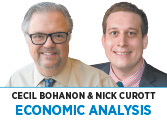Subscriber Benefit
As a subscriber you can listen to articles at work, in the car, or while you work out. Subscribe Now Income inequality is and always will be a persistent issue in the political landscape of any country. A bare majority of American workers in a 2018 Gallup survey, 52% to be exact, thought their pay was “about right” or offered “no opinion.” On the other hand, 43% thought they were underpaid while only 5% thought they were overpaid.
Income inequality is and always will be a persistent issue in the political landscape of any country. A bare majority of American workers in a 2018 Gallup survey, 52% to be exact, thought their pay was “about right” or offered “no opinion.” On the other hand, 43% thought they were underpaid while only 5% thought they were overpaid.
A 2015 study in the Harvard Business Review, using data from PayScale, surveyed 71,000 workers. The survey had the credentials, work history and salary of each worker. By matching workers with comparable positions and backgrounds, the study made an estimate of workers who were paid “above” market, “at” market and “below” market. The results reveal that “a whopping two-thirds of people who are being paid the market rate believe they’re actually underpaid, representing a huge discrepancy.” Moreover, over one-third of those deemed to be paid above market thought they were paid below-market rates.
This is human nature going back to Cain and Abel. We are all much more likely to believe we are not getting what we should be getting and that the other guy is getting more than what he rightfully deserves. Perhaps that is why the Ten Commandments enjoin us against an attitude only once, in the 10th commandment: Thou shalt not covet. (Exodus 20:17/KJV) The other nine are about actions: Don’t murder, don’t steal, don’t make idols and so on.
So to what extent is income inequality a problem? The conventional method of measuring income inequality is to examine households’ income without accounting for taxes and most government transfers. By this measure, there is no question that income inequality among households has risen over the last 50 years. Yet, both taxes paid and transfers received are crucial in assessing inequality in households’ access to goods and services. The work of Phil Gramm and John Early on the issue shows that—if one incorporates federal, state and local taxes paid by households, and government transfer to households, such as food stamps—household consumption inequality has not really changed much over the last 50 years.
Is it possible that the “crisis” in income inequality is more about the human tendency for those who are relatively well off to envy those who are better off, and not so much about concern for the plight of those in the bottom fifth of the income distribution? You know, there will always be a bottom fifth.•
__________
Bohanon and Curott are professors of economics at Ball State University. Send comments to [email protected].
Please enable JavaScript to view this content.
